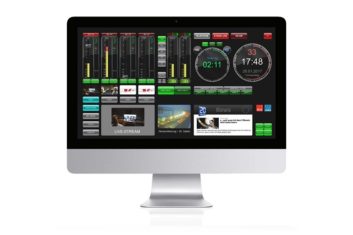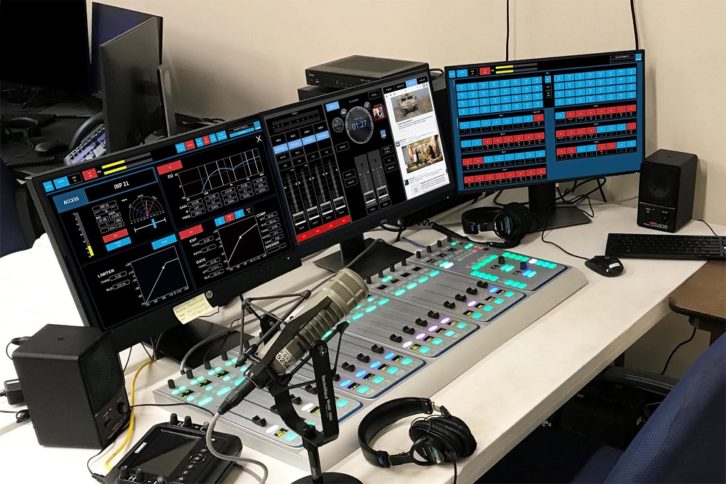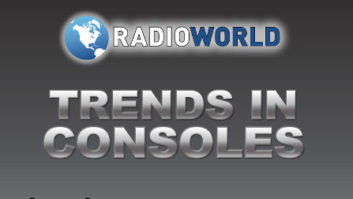 Our recent ebook “Console Tech 2021” explores how the physical and virtual surfaces that radio stations and online audio creators use are evolving.
Our recent ebook “Console Tech 2021” explores how the physical and virtual surfaces that radio stations and online audio creators use are evolving.
Johan Boqvist is senior product manager, radio on-air at Lawo.
Radio World: Name a specific feature or option of your surface or GUI that you wish to highlight.
Johan Boqvist: Modern radio consoles are no longer standalone physical devices, but are steadily becoming a combination of physical and on-screen interfaces that complement and mirror each other. Lawo has led the way in this area with a software GUI called VisTool, which comes with every Lawo radio mixer, runs on Windows PCs and supports touchscreen controls.
Lawo was one of the first companies to augment physical controls with virtual controls, which makes VisTool the most mature console GUI on the market.
RW: What makes it notable?
Boqvist: While every Lawo console comes with a basic version of VisTool, there’s an Unlimited version that allows users to completely customize the look, feel and layout of the control GUI with their own

layouts and graphics.
They can literally build a virtual console with it, complete with on-screen, touch-sensitive faders, rotary controls, meters, pushbuttons and more. VisTool can even integrate controls for studio peripherals, including playout systems, phones, codecs, video feeds and social media platforms, etc.
[Related: “How to Choose Your Next Radio Console”]
What makes this notable is that broadcasters have begun to use VisTool not only to control their consoles, but their entire studios. They’re building remote-control solutions with it, where a remote operator connected via IP has complete access to all studio equipment and can run it as if they were physically present in the studio.

In these days of social distancing, this has proven to be a very in-demand solution, both for stations seeking to be prepared for emergency operation, and for remote talent working from home studios or other locations.
RW: What are other notable features available now in surfaces that may not have been a few years ago?
Boqvist: We’re seeing more and more automation features appearing in radio consoles.
Lawo has pioneered this, with things like AutoMix automatic group mixing and Autogain mic gain features, and also with the ability to set, save and recall settings, customized to individual talent, through the use of snapshots and motorized faders. Built-in touch-sensitive GUIs beginning to appear in radio consoles as well, a feature that was previously available only in large live-sound audio consoles like Lawo’s mc2 series.
RW: For someone who hasn’t bought a console recently, describe the level of “customization” available.
Boqvist: All Lawo radio products are customizable to meet every customer’s unique requirements and workflows. This means console configurations from two to 60 faders, with IP and/or baseband audio interfaces, redundant and non-redundant DSP cores, power distribution, network interfaces and protocols, and a number of DSP licenses and software add-ons to choose from, depending on the application.
The behavior, logic, functions and labels in the console and virtual extension are fully user configurable with the help of intuitive, use-to-use graphical editors and software.
But if the customer doesn’t require custom configuration, Lawo radio consoles can be delivered with a standard configuration and pre-configured plug-and-play applications.
These standard configurations are frequently updated by our configuration experts based on user feedback and market requirements, to meet the requirements for the majority of radio installations. These standard configurations can also be used as baselines for Lawo’s engineering team to use when collaborating with clients to develop custom solutions.
RW: How many surfaces can an “engine” accommodate?
Boqvist: Great question! But there’s no set answer for every engine and every manufacturer; it depends upon the hardware used. Obviously, hardware with greater power and resources is better.
In Lawo’s case, we have been receiving more and more requests for shared and distributed DSP resources, and for good reason — this approach not only saves money, rack space and power (an environmentally friendly alternative), it makes possible many new options for sharing audio and logic between “logical consoles” and studios without external connections. Our solution is Power Core MAX, a license option for our Power Core DSP mixing engine, which is a 1RU device that’s one of the most powerful DSP devices ever made for broadcast.
MAX is short for “Multiple Access,” and this license enables the Power Core device to host up to four consoles, either physical, virtual or any combination of the two. The current generation of hardware supports up to 60 faders and 96 parallel DSP channels. That’s more audio resources than a typical single radio application requires, but ideal for sharing those resources among multiple smaller control interfaces.
Our clients tell us this is a perfect option for multiple consoles in a single studio, or for co-located studios in close proximity, since physical I/O can also be easily shared as well as control.
Other applications are virtual remote studios with a shared core and DSP engine deployed in a datacenter, with audio connectivity over Ravenna/AES67. Power Core units already in the field can be easily upgraded to MAX functionality with a simple license upgrade.
RW: How will the role of physical surfaces change in the next five years?
Boqvist: Like the rest of the industry, Lawo clearly sees a trend towards more and more virtual consoles and interfaces. As pioneers in virtualization, first with the development of our VisTool graphical control interface, and then with our RƎLAY virtual mixing and routing software, we support this trend and have plenty of experience, having helped customers around the world to deploying virtual user interfaces for production and live broadcasting.
At the same time, customers still want modular physical consoles, very often in combination with virtual interfaces. While we believe that a virtual interface can’t completely replace a physical surface in every application, we think that modular and hybrid console combinations, with open APIs for software integration, are the future.
This enables flexible deployments and solutions designed for a common and unified workflow across a number of different application scenarios. Lawo Product Management and R&D are working with our UX team and with our clients to develop some exciting products in this vein, which are scheduled for next year, with interfaces that bring modern design and consistent workflow patterns together to unify the overall user experience — whether clients choose physical consoles, virtual consoles or a mixture of both.







